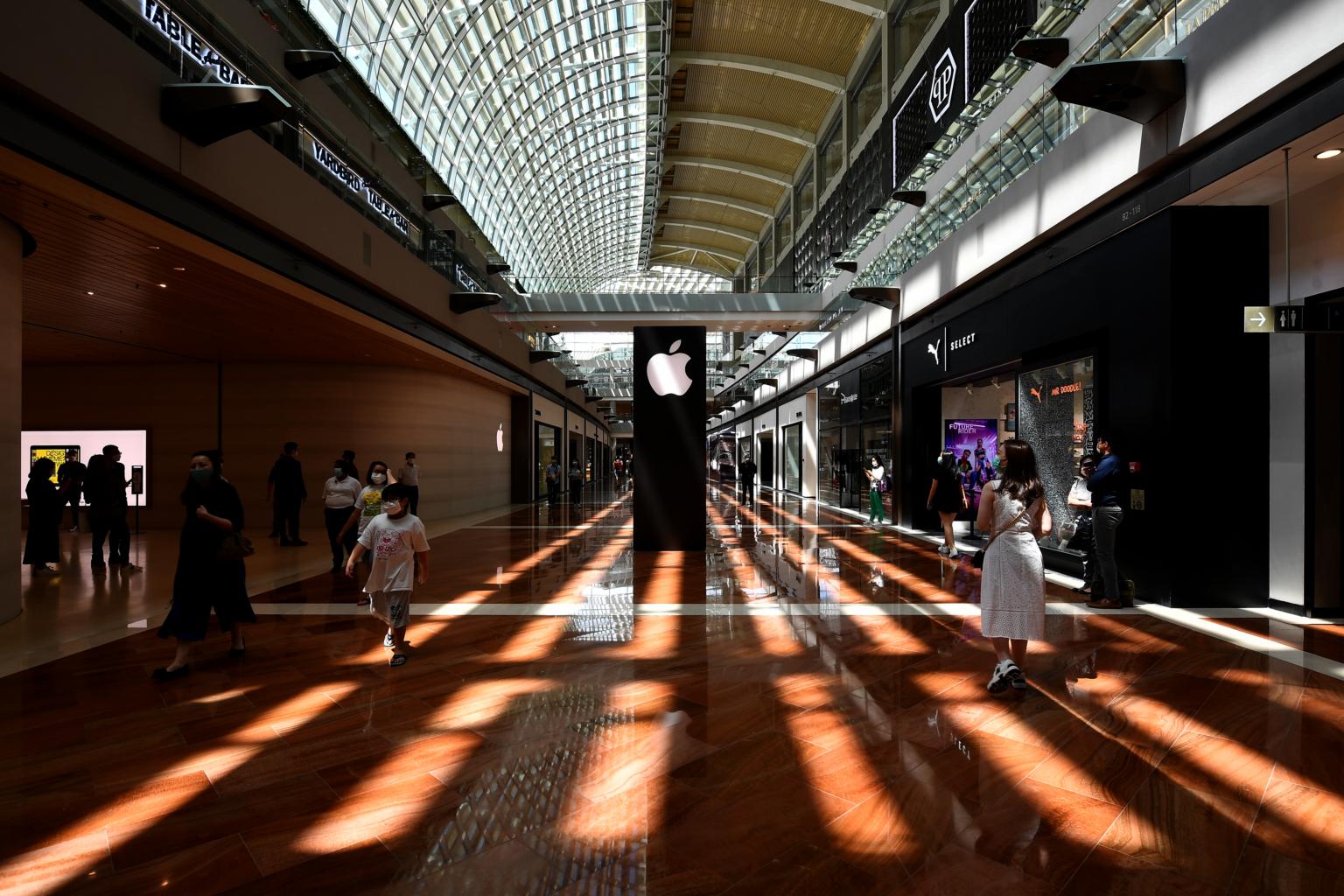Singapore retail sales up 1.9% in November, slowing after October's iPhone 13 boost
Sign up now: Get ST's newsletters delivered to your inbox

Sales in October were partially skewed by new product launches, like that of Apple's iPhone 13, boosting mobile phone sales.
ST PHOTO: LIM YAOHUI
Follow topic:
SINGAPORE - Retail sales in Singapore expanded at a slower pace in November compared with the previous month and remained below pre-pandemic levels, although sales that took place online held steady for the period.
Online sales accounted for a slightly larger slice of total November sales, amid year-end online shopping events such as Singles’ Day and Black Friday.
Online sales accounted for a slightly larger slice of total November sales, amid year-end online shopping events such as Singles’ Day and Black Friday.
This was supported by online purchases of computer and telecommunications equipment, which made up more than half that industry’s total sales for the month, according to data released by the Singapore Department of Statistics on Wednesday (Jan 5).
Online takings of furniture and household equipment accounted for 34.2 per cent.
The estimated total retail sales value in November was $3.7 billion, of which an estimated 16.9 per cent was from online sales, slightly higher than the 15.2 per cent recorded in October.
On a year-on-year basis, online sales rose 23 per cent in November, marking seven consecutive months of expansion, according to UOB economist Barnabas Gan.
The estimated total retail sales value in November was $3.7 billion, of which an estimated 16.9 per cent was from online sales, slightly higher than the 15.2 per cent recorded in October.
On a year-on-year basis, online sales rose 23 per cent in November, marking seven consecutive months of expansion, according to UOB economist Barnabas Gan.
Total takings at the till rose 1.9 per cent year on year, moderating from the 7.5 per cent growth in October, according to the Singapore Department of Statistics data.
Sales in October were partially skewed by new product launches, such as those of Apple's iPhone 13, boosting mobile phone sales.
November's year-on-year performance was nevertheless better than the 0.7 per cent growth tipped by economists in a Bloomberg poll.
Mr Gan said tourism-related demand might have supported November’s retail sales, unlike previous months.
Singapore saw 41,140 inbound visitors that month, nearly double the 23,980 in October, as the Republic’s hotel sector had its highest occupancy rates and revenue per available room since the pandemic broke out.
Singapore saw 41,140 inbound visitors that month, nearly double the 23,980 in October, as the Republic’s hotel sector had its highest occupancy rates and revenue per available room since the pandemic broke out.
The continued retail sales expansion points to a resilient recovery environment for Singapore’s retail sector, said Mr Gan.
“For the year ahead, retail sales performance will depend on the recovery of Singapore’s domestic economy and the gradual reopening of its borders. Barring the exacerbation of Covid-19-related risks in Singapore and around the region, we pencil retail sales to expand by 6 per cent in 2022,” he added.
Ms Selena Ling, OCBC Bank’s head of treasury research and strategy, said the latest data signals that local consumption amid the year-end festive season, and vaccinated travel lane (VTL) visitor arrivals, are holding up.
“This may be of some comfort to the retail sector, even if the Omicron variant seems to have taken the shine off VTL hopes,” she said.
She added that the growth in retail sales might lose steam and come in at 2 per cent in 2022 due to last year’s high base. Retail sales is forecast to grow by around 10 per cent for the whole of 2021.
Sales were mixed across industries. Petrol service stations, watches and jewellery, and apparel and footwear were among those that enjoyed higher takings in November compared with a year ago.
“This may be of some comfort to the retail sector, even if the Omicron variant seems to have taken the shine off VTL hopes,” she said.
She added that the growth in retail sales might lose steam and come in at 2 per cent in 2022 due to last year’s high base. Retail sales is forecast to grow by around 10 per cent for the whole of 2021.
Sales were mixed across industries. Petrol service stations, watches and jewellery, and apparel and footwear were among those that enjoyed higher takings in November compared with a year ago.
But industries such as motor vehicles, optical goods and books, department stores, and computer and telecommunications equipment saw sales fall.
The food and beverage (F&B) services sector saw 0.6 per cent growth in sales in November over the same month in 2020.
It reversed a 4.5 per cent decline in October that was due to tightened Covid-19 restrictions limiting group size for dining at food and beverage (F&B) establishments to two fully vaccinated people.
F&B turnover rose 10.4 per cent in November over the previous month on a seasonally adjusted basis. However, the takings still remained below pre-Covid-19 levels.
Restaurant sales fell 4.9 per cent year on year in November because of tighter social restrictions. Dining in was allowed for groups of up to two fully vaccinated people from Nov 1 to 21, and up to five fully vaccinated diners from Nov 22.
It was allowed for groups of up to five for the whole of October 2020 and November 2020.
Turnover of food caterers jumped 38.9 per cent because of the low base last year when catering demand was low.
Takings at fast-food outlets dipped 0.7 per cent, reversing October's 10.1 per cent growth.
Cafes foodcourts and other eating places saw a 3.1 per cent rise owing to higher demand for food delivery.
The total sales value of F&B services was estimated at $706 million in November. Of this, online sales made up 32.8 per cent, lower than October's 38.4 per cent.

